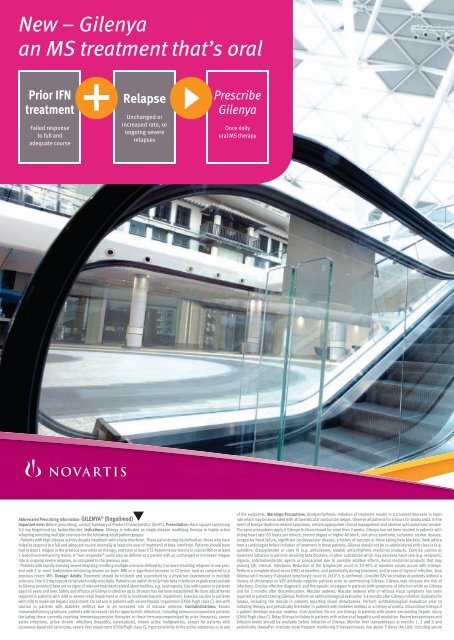You also want an ePaper? Increase the reach of your titles
YUMPU automatically turns print PDFs into web optimized ePapers that Google loves.
New – Gilenyaan MS treatment that’s oralPrior IFNtreatmentFailed responseto full andadequate courseRelapseUnchanged orincreased rate, orongoing severerelapsesPrescribeGilenyaOnce dailyoral MS therapyAbbreviated Prescribing Information: GILENYA ® (fingolimod)Important note: Before prescribing, consult Summary of Product Characteristics (SmPC). Presentation: Hard capsule containing0.5 mg fingolimod (as hydrochloride). Indications: Gilenya is indicated as single disease modifying therapy in highly activerelapsing remitting multiple sclerosis for the following adult patient groups:- Patients with high disease activity despite treatment with a beta-interferon. These patients may be defined as: those who havefailed to respond to a full and adequate course (normally at least one year of treatment) of beta-interferon. Patients should havehad at least 1 relapse in the previous year while on therapy, and have at least 9 T2-hyperintense lesions in cranial MRI or at least1 Gadolinium-enhancing lesion. A “non-responder” could also be defined as a patient with an unchanged or increased relapserate or ongoing severe relapses, as compared to the previous year.- Patients with rapidly evolving severe relapsing remitting multiple sclerosis defined by 2 or more disabling relapses in one year,and with 1 or more Gadolinium enhancing lesions on brain MRI or a significant increase in T2 lesion load as compared to aprevious recent MRI. Dosage: Adults: Treatment should be initiated and supervised by a physician experienced in multiplesclerosis. One 0.5 mg capsule to be taken orally once daily. Patients can switch directly from beta-interferon or glatiramer acetateto Gilenya provided there are no signs of relevant treatment-related abnormalities, e.g. neutropenia. Use with caution in patientsaged 65 years and over. Safety and efficacy of Gilenya in children up to 18 years has not been established. No dose adjustmentsrequired in patients with mild to severe renal impairment or mild to moderate hepatic impairment. Exercise caution in patientswith mild to moderate hepatic impairment. Do not use in patients with severe hepatic impairment (Child-Pugh class C). Use withcaution in patients with diabetes mellitus due to an increased risk of macular oedema. Contraindications: Knownimmunodeficiency syndrome, patients with increased risk for opportunistic infections, including immunocompromised patients(including those currently receiving immunosuppressive therapies or those immunocompromised by prior therapies), severeactive infections, active chronic infections (hepatitis, tuberculosis), known active malignancies, except for patients withcutaneous basal cell carcinoma, severe liver impairment (Child-Pugh class C), hypersensitivity to the active substance or to anyof the excipients. Warnings/Precautions: Bradyarrhythmia: Initiation of treatment results in a transient decrease in heartrate which may be associated with atrioventricular conduction delays. Observe all patients for 6 hours for bradycardia. In theevent of bradyarrhythmia-related symptoms, initiate appropriate clinical management and observe until symptoms resolve.The same precautions apply if Gilenya is discontinued for more than 2 weeks. Gilenya has not been studied in patients withsitting heart rate

















